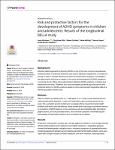Risk and protective factors for the development of ADHD symptoms in children and adolescents: Results of the longitudinal BELLA study
Wüstner, Anne
Otto, Christiane
Schlack, Robert
Hölling, Heike
Klasen, Fionna
Ravens-Sieberer, Ulrike
Background
Attention-deficit/hyperactivity disorder (ADHD) is one of the most common neurodevelopmental disorders in childhood worldwide, and causes significant impairments in overall functioning. In order to develop effective prevention and intervention programs, knowledge of the determinants that have an impact on the onset and development of ADHD symptoms is essential. So far, little is known about factors affecting ADHD symptoms in children and adolescents over time. Therefore, this study investigates potential psychosocial risk and protective factors for ADHD symptoms based on cross-sectional and longitudinal data of a German population-based study.
Methods
Data on children and adolescents (n = 1,384 aged 11 to 17 years) were collected at three measurement points (baseline, 1-year and 2-year follow-ups) covering a period of two years. We used latent growth modelling to investigate effects of parental mental health problems (risk factor) and self-efficacy, family climate and social support (protective factors) on symptoms of ADHD based on cross-sectional as well as longitudinal data. Sociodemographic factors, pre- and postnatal factors, and comorbid symptoms of internalizing and externalizing mental health problems were considered as covariates.
Results
At baseline, male gender, younger age, stronger aggressive behavior, and stronger parental mental health problems were related to more ADHD symptoms. Longitudinal analyses showed that female gender, migration status, increasing symptoms of generalized anxiety, increasing aggressive behavior and increasing parental mental health problems were associated with stronger increase of ADHD symptoms over time. However, improving family climate was related to decreasing ADHD symptoms over time. We further found moderator effects for social support.
Conclusion
The findings of the study provide important information concerning risk and protective factors in the context of ADHD. Hence, the results may be integrated into the planning and implementation of future prevention and early intervention strategies that target affected children and adolescents.

